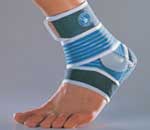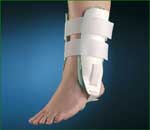Os Trigonum Syndrome & Football
July 24 2008 | Articles
Os Trigonum Syndrome is signalled by pain felt at the back of the ankle. This pain results from the impingement of soft tissues on the Os Trigonum, a bony prominence located right behind the Talus bone.
The Os Trigonum occurs in one out of 20 people. However, it is remarkably more common in professional football players, with one in five players reportedly having the prominence. This increased occurrence in footballers is linked to the repeated hyper plantar flexion involved in pushing the ankle forwards, a movement common to football. As a result of the impingement, there is painful inflammation of the tissues at the back of the ankle.
Os Trigonum Syndrome Signs & Symptoms
The presence of pain in the back of the ankle would be the earliest indication of Os Trigonum Syndrome. An examination by a physician or a chartered physiotherapist would reveal that the area in front of the Achilles tendon would be painful to touch. Also, the physician or physiotherapist may find the bony prominence palpable. By conducting a lateral x-ray of the foot, a full and accurate diagnosis of Os Trigonum Syndrome can be made.
Os Trigonum Syndrome Treatment
What you can do
In order to facilitate healing of the soft tissues, it is necessary to have a 4-6 week break from football. Ice therapy involves application of ice packs at regular intervals, for 20 minutes each time which reduces inflammation and pain.

View Reusable ice pack
If the inflammation in the soft tissue does not subside, a doctor may prescribe anti-inflammatory medication or administer a corticosteroid injection to help with the swelling.
However, if the ankle pain and swelling continue to persist, it may be necessary for an orthopaedic consultant to operate on the foot and remove the injured bony prominence. With the help of a physiotherapist, a full return to football can happen after 4 – 8 weeks of rehabilitation.
Os Trigonum Syndrome Prevention
What you can do
The prevention of Os Trigonum Syndrome is especially difficult in individuals who already possess a bony prominence behind their Talus bone. However, it may be helpful to use an ankle brace that prevents excessive plantar flexion, a movement that involves pushing the feet down, such as in pressing down a car’s gas pedal. The use of this ankle brace will protect the soft tissue from impingement and thus, will help prevent the development of the Os Trigonum Syndrome.
Football Rescue Recommends Ankle Supports
Ankle strapping is intended to strengthen the internal and external ligaments which hold the tibio-fubular mortise (ankle joint) in place. These supports stimulate a strapping technique. The flexible straps are fitted beneath the heel, in the direction of the joint and push from the bottom to the top which locks the ankle tendons.
Lateral movement (twisting the ankle towards the outside) is prohibited and other movements remain intact. A fine perforated neoprene allows transpiration. These supports are ideal for footballers that suffer from twisting the ankle joint.
View Ankle Supports



